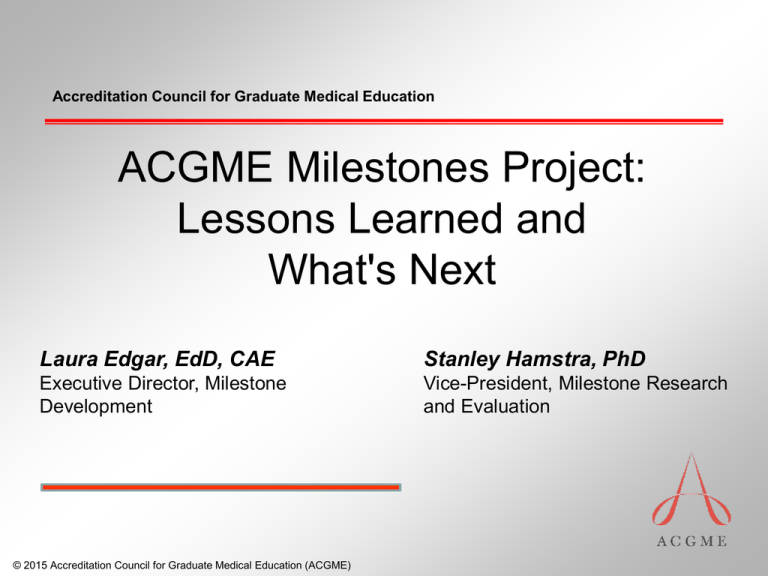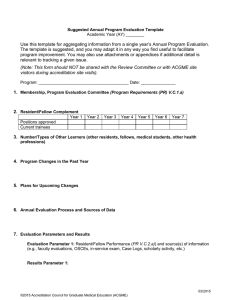Slide Template
advertisement

Accreditation Council for Graduate Medical Education ACGME Milestones Project: Lessons Learned and What's Next Laura Edgar, EdD, CAE Stanley Hamstra, PhD Executive Director, Milestone Development Vice-President, Milestone Research and Evaluation © 2015 Accreditation Council for Graduate Medical Education (ACGME) Topics for Discussion • • • • • Milestones Background – a recap How the Milestones Were Developed Phase 1 Data Current and Prospective Research Milestones 2.0 © 2015 Accreditation Council for Graduate Medical Education (ACGME) Milestones Background – What? • Description of the performance levels residents are expected to demonstrate for skills, knowledge, and behaviors in the six competency domains • Framework of observable behaviors • One indicator of a program’s educational effectiveness © 2015 Accreditation Council for Graduate Medical Education (ACGME) Milestones Background – What? • What do they know? (Medical Knowledge) • What can they do? (Patient Care) • How do they conduct themselves? (Interpersonal and Communication Skills, Practice-based Learning and Improvement, Professionalism, and Systems-based Practice) © 2015 Accreditation Council for Graduate Medical Education (ACGME) Milestones Background – Why? • Fulfill the promise of the Outcome Project • Increased use of educational outcome data in accreditation • ACGME accountability to public • Support the educational process © 2015 Accreditation Council for Graduate Medical Education (ACGME) Milestones Background – How are they used? ACGME • Accreditation – continuous monitoring of programs; lengthening of site visit cycles • Public Accountability – report at a national level on competency outcomes • Community of practice for evaluation and research, with focus on continuous improvement Residency Programs • Guide curriculum development • More explicit expectations of residents • Support better assessment • Enhanced opportunities for early identification of under-performers Milestones Certification Boards Residents • Potential use – ascertain whether individuals have demonstrated qualifications needed to sit for Board exams • Increased transparency of performance requirements • Encourage resident self-assessment and self-directed learning • Better feedback to residents © 2015 Accreditation Council for Graduate Medical Education (ACGME) Milestone Development – Who? Working Group • Review Committee • Certification Boards • Program Directors • Residents/ Fellows • Specialty Societies Advisory Group • Leaders within the specialty community © 2015 Accreditation Council for Graduate Medical Education (ACGME) Milestone Development – How? © 2015 Accreditation Council for Graduate Medical Education (ACGME) Milestone Development – How? • Each specialty began the same way with a review of available documents: • • • • • Program Requirements Certification Exam Outlines Competency Statements created by specialty groups National Curricula Milestones created by other specialties © 2015 Accreditation Council for Graduate Medical Education (ACGME) Milestone Development – How? • Brainstorming of topics that were important to resident education • Drafting, rejecting, redrafting, etc • Development of what the Working Group believed was a near final product • Review by the Advisory Group and Review Committee • Survey of Program Directors • Final edits and publication © 2015 Accreditation Council for Graduate Medical Education (ACGME) FUN FACT – Number of Volunteers There were 916 volunteers who created all the milestones! That is 3 times as many current RRC members that are serving at the ACGME © 2015 Accreditation Council for Graduate Medical Education (ACGME) FUN FACT – Number of Meetings It took about 100 meetings to create the milestones! Lightning strikes the earth approximately 100 times every second! © 2015 Accreditation Council for Graduate Medical Education (ACGME) FUN FACT – Number of Institutions Represented There were representatives from over250 different institutions! There are 250 toothpicks in a standard box © 2015 Accreditation Council for Graduate Medical Education (ACGME) FUN FACT – Number of Volunteer Hours It took over 1500 volunteer hours to create all the milestones! It takes 1500 flight hours to become a certified pilot © 2015 Accreditation Council for Graduate Medical Education (ACGME) FUN FACT – Number of Milestone Threads There were 1916 milestone threads created! There are over 1900 types of edible insects in the world © 2015 Accreditation Council for Graduate Medical Education (ACGME) VALIDITY Validity of Milestones Data • Evidence of progression in NAS* • to support CBME • comprehensive approach to competencies • “entrustability” • how do we know this is working? • CQI approach • Assessment validity framework • validity depends on research and CQI model *Nasca et al. The Next GME Accreditation System: Rationale and Benefits. N Engl J Med, 366:1051-6;2012. © 2015 Accreditation Council for Graduate Medical Education Milestone Database • • • • • • Dec 2013 = 5 specialties June 2014 = 8 specialties Dec 2014 = 90 specialties June 2015 = 96 specialties Dec 2015 = 140 specialties June 2016 = all specialties reporting Academic Year-End © 2015 Accreditation Council for Graduate Medical Education Milestone Database • • • • • • Dec 2013 = 5 specialties June 2014 = 8 specialties Dec 2014 = 90 specialties June 2015 = 96 specialties Dec 2015 = 140 specialties June 2016 = all specialties reporting Academic Year-End © 2015 Accreditation Council for Graduate Medical Education Number of Residents AY 2013-14 (i.e. single data point = June 2014) 1)Neurosurgery (NS, N = 1,272) 2)Orthopedic surgery (OS, N = 3,574) 3)Emergency Medicine (EM, N = 5,806) 4)Diagnostic Radiology (DR, N = 4,686) 5)Urology (URO, N = 1,167) 6)Internal Medicine (IM, N = 23,915) 7)Internal Medicine / Pediatrics (IM/PEDS, N = 1,448) 8)Pediatrics (PEDS, N = 8,837) © 2015 Accreditation Council for Graduate Medical Education Milestones • How do we know we’re improving? © 2015 Accreditation Council for Graduate Medical Education Data Extraction and Analysis • For each resident (across all PGY-levels), we determined whether they had attained the recommended Level 4 (or higher) for all subcompetencies within a core competency. • Then we determined the percentage of residents within a specialty who attained Level 4 across all programs. © 2015 Accreditation Council for Graduate Medical Education Learning Curves (theoretical) © 2015 Accreditation Council for Graduate Medical Education Learning Curves (theoretical) Learning Curves (theoretical) Residents Attaining Level 4 or Higher Internal Medicine Proportion 1 0.5 0 PGY1 PC MK SBP © 2015 Accreditation Council for Graduate Medical Education PGY2 PBLI PGY3 PROF ICS Residents Attaining Recommended Graduation Targets Percent of Senior-most Residents who Attained Level 4 or Higher IM DR (N=7157) (N=1140) NS (N=113) URO (N=279) OS (N=691) PC 77% 85% 54% 77% 60% MK 81 83 72 93 65 SBP 78 79 73 76 87 PBLI 76 83 77 75 89 PROF 82 85 92 81 89 ICS 86 86 83 82 89 PC-patient care; MK-medical knowledge; SBP-systems-based practice; PBLI-practice-based learning and improvement; PROF-professionalism; ICS-interpersonal and communication skills. © 2015 Accreditation Council for Graduate Medical Education Residents Attaining Level 4 or Higher © 2015 Accreditation Council for Graduate Medical Education Possible Interpretation: Neurological Surgery Competence in PC is the most difficult to attain. This may represent differences in clinical experience for selected sub-competencies thus, the full achievement of Level 4 in the Patient Care competency may be impossible for those residents. © 2015 Accreditation Council for Graduate Medical Education Neurological Surgery Level 4 Attainment per Patient Care Sub-Competency Question Key Q8 Traumatic Brain Injury Q6 Spinal Neurosurgery Q1 Brain Tumor Q2 Critical Care Q5 Pediatric Neurological Surgery Q7 Vascular Neurosurgery Q3 Epilepsy and Movement Disorders Q4 Pain and Peripheral Nerves RESEARCH Advisory Groups: Analytic John Norcini (FAIMER) Reed Williams (SIU/IU) Rachel Yudkowski (UIC) Ara Tekian (UIC) CCC Karen Hauer (UCSF) Kathy Andolsek (Duke) Jamie Padmore (Medstar Washington) David Berg (Yale) © 2015 Accreditation Council for Graduate Medical Education Selected Research Projects in Progress Emergency Medicine initial validity study Factor structure supported three factor design of EM certification (in press)1 Expected correlation between ITE and MK milestones Exploring ITE and milestones associative studies with ABFM and ABPeds Neurosurgery PD and resident survey of first year experience Hauer - IM CCC experience studies 1Beeson MS, Holmboe ES, Korte RC, Nasca TJ, Brigham T, Russ CM, Whitley CT, Reisdorff EJ. Initial Validity Analysis of the Emergency Medicine Milestones. Acad Emerg Med. 2015; in press. © 2015 Accreditation Council for Graduate Medical Education NAS AS CQI Supporting the CQI Vision of NAS Milestones data should never be used for highstakes decisions by RRC’s to accredit individual programs. Rather, in the spirit of CQI, it should be used for identifying gaps in training, or weaknesses in the data collection process to enhance the quality of the curricula and the validity of the data. Bottom Line: the Milestones data should represent the resident’s underlying ability or competency. Goal of Milestones: to enhance the quality of the judgment of the resident’s progression Milestones CQI Process True Score Time Milestones CQI Process True Score Time Putting processes in place to reduce “Construct-Irrelevant Variance” Milestones CQI Process Pre-NAS True Score Time What’s Next? Milestones 2.0 • Data, comments and suggestions are continually being monitored • Competency Crosswalk for Interpersonal and Communication Skills, Practice-based Learning and Improvement, Professionalism, and Systems-based Practice © 2015 Accreditation Council for Graduate Medical Education (ACGME) What’s Next? Milestones 2.0 • Milestones Summit with representatives from the ABMS Member Boards, AOA Certifying Boards and ACGME Review Committees • Development will begin late 2016 © 2015 Accreditation Council for Graduate Medical Education (ACGME) Where do I find...? © 2015 Accreditation Council for Graduate Medical Education (ACGME) Milestone Resources Milestone Webpage: http://www.acgme.org/acgmeweb/tabid/430/ProgramandInstitutionalAccreditati on/NextAccreditationSystem/Milestones.aspx Milestone FAQs: http://www.acgme.org/acgmeweb/Portals/0/MilestonesFAQ.pdf Clinical Competency Committee Guidebook: http://www.acgme.org/acgmeweb/Portals/0/ACGMEClinicalCompetencyCommi tteeGuidebook.pdf © 2015 Accreditation Council for Graduate Medical Education (ACGME) We are here to help Milestones: milestones@acgme.org Laura Edgar ledgar@acgme.org Stanley Hamstra shamstra@acgme.org © 2015 Accreditation Council for Graduate Medical Education (ACGME)

